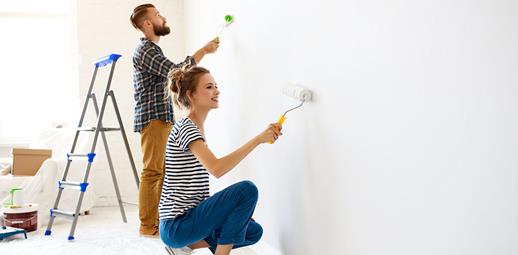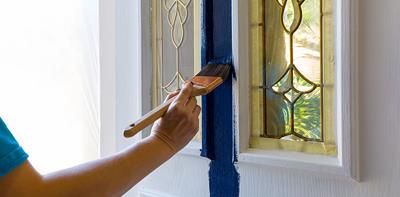
Freshening up your home and picking up those long overdue DIY jobs can be a rewarding and fun experience for the whole family.
Whether it’s putting up a shelf or painting your spare room, there’s always plenty to do around the house or in the garden.
The beauty of doing it yourself is not only the sense of accomplishment, but the money you can save by not calling in a professional. But it’s easy for costs to add up, so here are some tips on how to save money on your DIY efforts.
Create and stick to a budget
Even for small DIY jobs, it’s really helpful to plan out exactly what you want to do, and what materials and tools you’ll need to buy. That way you can set a budget and ensure you stick to it.
Find the cheapest online prices
B&Q, Homebase or Wickes? If you’re shopping for DIY supplies, you may have your go-to shop or website. But before clicking buy, make sure you’re getting the best deal available.
Try using a price comparison site like Google Shopping, which will trawl through retailers' products to find you the cheapest deal.
According to Which? most big-brand DIY retailers are gradually reopening their doors to customers and many of them are still offering online services.
Check for cashback
When trying to find bargains on DIY supplies online, check whether you can get some cash back for your purchase.
If you’ve not taken advantage of cashback offers before, in a nutshell they mean using a website like TopCashback or Quidco to earn back a percentage of what you spend.
Repurpose old furniture
If you want to make some improvements on a shoestring budget, then make use of what you already have.
For example, it’s easy to transform an old, worn piece of furniture into something brighter and more modern-looking. More often than not, it will simply require some sanding-down and a new lick of paint. If you’re updating an old chest of drawers, something as simple as adding some colourful handles can give it a new lease of life.
Reuse leftover DIY odds and ends
It’s amazing what uses you can find for off-cuts or other materials left over from a spot of DIY – especially if you turn to a site like Pinterest for inspiration.
Take leftover paint, for example. You could use it to paint photo frames, refresh old furniture, paint patterns or create a feature wall… the options are endless.
Perhaps you have some leftover tiles. Could you use some to create alternative coasters? Maybe they can be turned into a tabletop, or used to decorate around the side of a plant pot.
Make the most of YouTube
Although you might be happy to go it alone on a DIY project and save money by not calling in a tradesman, that doesn’t mean you can’t enlist a little expert help.
YouTube is a treasure trove full of video tutorials covering every DIY task imaginable. It can be helpful to check a few different videos before getting started.
When searching for a bit of advice on re-grouting your bathroom, for example, it’s easy to get distracted by all sorts of YouTube guides, like the ones you can find on how to dig out a swimming pool with your bare hands. As tempting as they may be, don’t let them distract you and stick to the task at hand.
Sometimes a quick call to a handy friend or family member can help too.
Don't blow your budget on tools
If you’re going it alone, then it can be a worthwhile investment to buy a few choice tools that will last for years. But don’t spend a fortune on something you won’t ever use again.
If you don’t know where to get started, then try looking at product reviews on sites like Which? Also, don’t forget to look out for second-hand items on sites such as eBay.
Take your time
Everyone has a DIY horror story or knows someone who does. It’s easy to think you’ll save some cash by doing it yourself, but sometimes a badly executed DIY task ends up costing you more, as you have to enlist the help of a professional.
As well as avoiding jobs that are beyond your skills, read the instructions thoroughly for any products or tools you're using, take your time to measure everything twice and be sure to cover carpets and furniture while painting.
A rushed job can also lead to mishaps or injuries. Remember to wear the right protective kit for the task at hand, such as eye protection when doing jobs that create dust.
Find a project that fits your DIY know-how
If you’re new to DIY or don’t feel very confident, stick to jobs like painting, draught-proofing or re-grouting your bathroom. These jobs may seem basic, but they are low-cost tasks that can really improve your home.
There are endless other small DIY and crafty projects you can take on. Just don’t overstretch yourself: research by Which? showed the DIY jobs that people are most likely to abandon include plumbing, tiling and carpentry, such as installing kitchen cabinets.
Clean up
It’s all too easy to spend a day doing jobs around the house and then collapse in a heap without properly sorting out your gear. But not taking care of your tools and equipment after you’ve used them can cost you a lot of money in the long run.
So, allow plenty of time to clean paint brushes and rollers. Also, if you have any paint left, then be sure to seal tins properly and store them somewhere cool and dry.
Make it a habit to clean your tools after each use before you return them to storage. By doing so, you might just save yourself a trip to the DIY store the next time you need to embark on some home improvements.
These simple DIY hacks can help you give your home a fresh look and save you a lot of money in the process.
No £25 admin fee
When you update your policy online, e.g. amend driver, address or car details.


